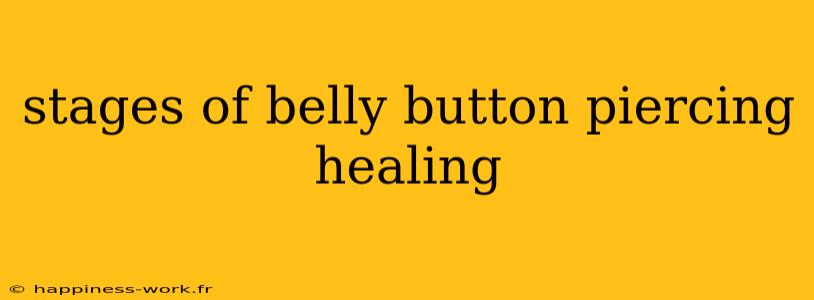Belly button piercings have gained immense popularity over the years, but many individuals overlook the importance of understanding the healing process. Knowing the stages of healing can help you ensure your new piercing stays healthy and free from infections. This article, inspired by information from WikiHow (original authorship credited where necessary), provides a comprehensive look at the healing stages, along with additional insights and practical tips for proper care.
Stage 1: Initial Healing (0-3 Weeks)
During the first few weeks post-piercing, your body begins to repair the tissue around the piercing. This stage can be characterized by:
- Swelling and redness: It's common for the area to look inflamed. Mild swelling is expected, and the area might feel warm to the touch.
- Bleeding or oozing: Some bleeding is normal, especially right after the procedure. However, if it persists, it may indicate an issue.
- Soreness: You may experience discomfort while moving your torso or when pressure is applied to the area.
Tips for Care:
- Avoid tight clothing: Wear loose-fitting clothes to minimize friction on the piercing.
- Keep it clean: Clean the area with a saline solution twice a day to help prevent infection.
- Avoid swimming: Steer clear of pools, hot tubs, and natural bodies of water, which can expose the piercing to bacteria.
Stage 2: Healing Phase (3-8 Weeks)
After the initial healing phase, your belly button piercing will start to stabilize. This period can take anywhere from 3 to 8 weeks.
- Reduced swelling: By now, the swelling should have diminished significantly.
- Crust formation: You may notice some crusty discharge around the piercing, which is part of the healing process.
- Itchiness: As the piercing heals, you might experience itchiness, which is a sign of healing.
Tips for Care:
- Patience is key: Avoid changing the jewelry during this phase unless absolutely necessary.
- Continue cleaning: Maintain a routine of cleaning the piercing but be careful not to over-clean, which can irritate the skin.
- Monitor for signs of infection: Keep an eye out for increased redness, warmth, or pus.
Stage 3: Maturation (8 Weeks - 6 Months)
This stage involves the piercing reaching a more stable state where the healing process continues but at a slower rate.
- Full healing time: Belly button piercings can take anywhere from 6 months to a year to fully heal, with the most sensitive period being the first 6 months.
- Possible irritation: Some people may experience irritation bumps, commonly known as keloids.
- Dullness in appearance: The area around the piercing may appear less vibrant as the tissue matures.
Tips for Care:
- Jewelry matters: Opt for high-quality materials like titanium or surgical steel to reduce the risk of allergic reactions.
- Regular checks: Continue to check the piercing for signs of infection or abnormal growth.
Stage 4: Final Healing (6 Months - 1 Year)
By this stage, the piercing should be relatively stable, but care should still be taken.
- Firm tissue formation: The skin around the piercing will feel firmer, and the irritation should decrease.
- Reduced sensitivity: You’ll notice that the area is less sensitive than it was during the earlier stages.
Tips for Care:
- Consider jewelry changes: Once fully healed, you can change your jewelry, but ensure it is appropriate for healed piercings.
- Ongoing cleanliness: Keep the area clean, especially if you engage in sports or activities that may cause excessive sweating or irritation.
Conclusion
Understanding the stages of belly button piercing healing is essential for ensuring that your piercing heals well without complications. While the information provided here offers a solid overview, it's also important to consult with a professional piercer or healthcare provider if you have concerns about your piercing. Additionally, remember to prioritize hygiene and aftercare to help facilitate the healing process.
By paying attention to your body’s signals and taking proactive steps, you can enjoy your new belly button piercing and flaunt it with confidence!
References
This article was inspired by the original content from WikiHow, written by community contributors.
